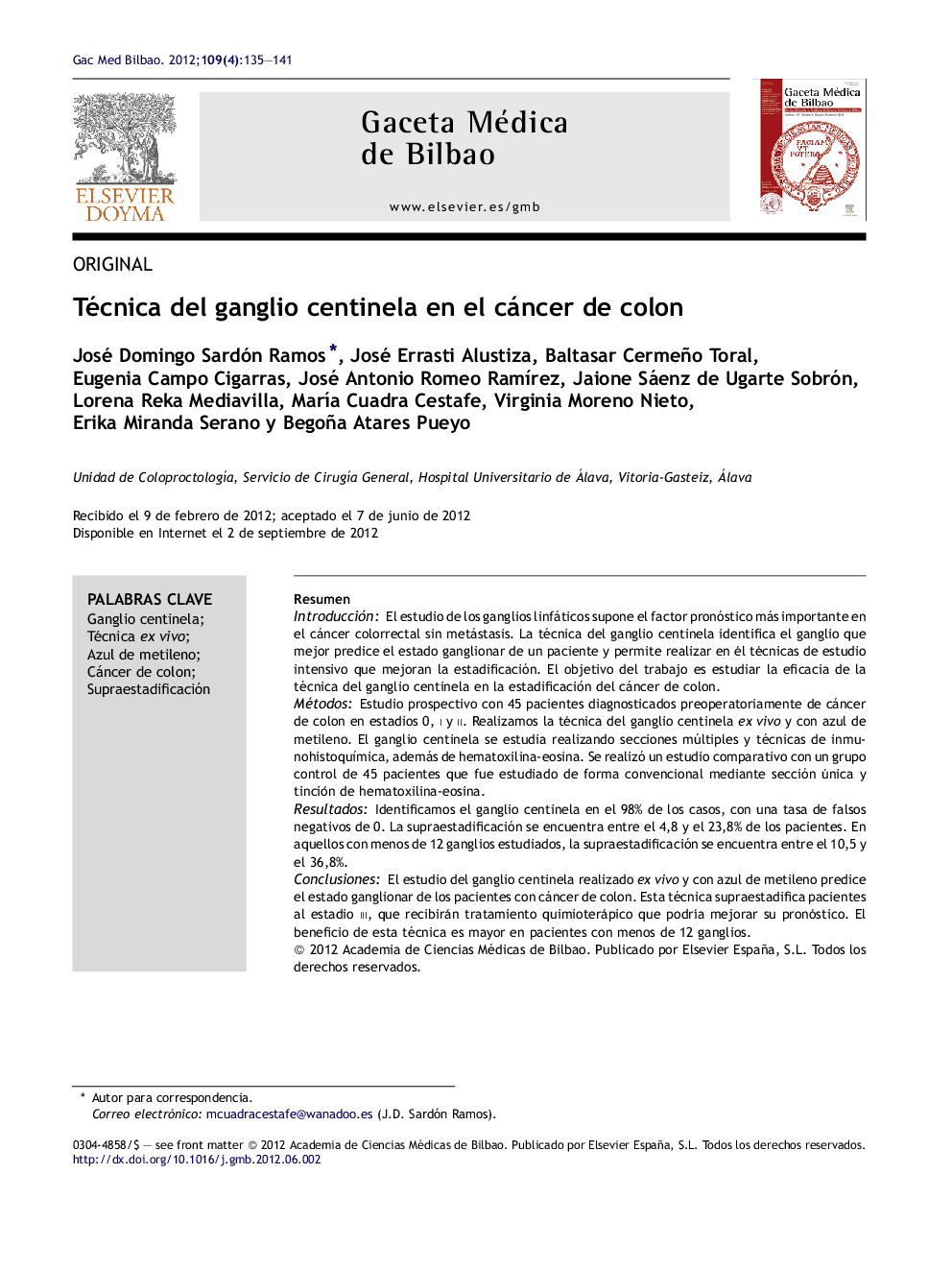| کد مقاله | کد نشریه | سال انتشار | مقاله انگلیسی | نسخه تمام متن |
|---|---|---|---|---|
| 3472812 | 1596700 | 2012 | 7 صفحه PDF | دانلود رایگان |

ResumenIntroducciónEl estudio de los ganglios linfáticos supone el factor pronóstico más importante en el cáncer colorrectal sin metástasis. La técnica del ganglio centinela identifica el ganglio que mejor predice el estado ganglionar de un paciente y permite realizar en él técnicas de estudio intensivo que mejoran la estadificación. El objetivo del trabajo es estudiar la eficacia de la técnica del ganglio centinela en la estadificación del cáncer de colon.MétodosEstudio prospectivo con 45 pacientes diagnosticados preoperatoriamente de cáncer de colon en estadios 0, i y ii. Realizamos la técnica del ganglio centinela ex vivo y con azul de metileno. El ganglio centinela se estudia realizando secciones múltiples y técnicas de inmunohistoquímica, además de hematoxilina-eosina. Se realizó un estudio comparativo con un grupo control de 45 pacientes que fue estudiado de forma convencional mediante sección única y tinción de hematoxilina-eosina.ResultadosIdentificamos el ganglio centinela en el 98% de los casos, con una tasa de falsos negativos de 0. La supraestadificación se encuentra entre el 4,8 y el 23,8% de los pacientes. En aquellos con menos de 12 ganglios estudiados, la supraestadificación se encuentra entre el 10,5 y el 36,8%.ConclusionesEl estudio del ganglio centinela realizado ex vivo y con azul de metileno predice el estado ganglionar de los pacientes con cáncer de colon. Esta técnica supraestadifica pacientes al estadio iii, que recibirán tratamiento quimioterápico que podría mejorar su pronóstico. El beneficio de esta técnica es mayor en pacientes con menos de 12 ganglios.
IntroductionThe study of lymph nodes is the most important prognostic factor in colorectal cancer without metastasis. The sentinel lymph node technique identifies the lymph node that best predicts the patient's lymph node status and allows the performance of techniques of intensive study that improve staging. The aim of this study was to evaluate the efficacy of the sentinel lymph node technique in the staging of colon cancer.MethodsWe performed a prospective study of 45 patients preoperatively diagnosed with colon cancer in stages 0, i and ii. We carried out the sentinel lymph node technique ex vivo and with methylene blue. The sentinel lymph node was studied through multiple sections and immunohistochemical techniques in addition to hematoxylin and eosin staining. We performed a comparison with a control group of 45 patients who were studied through a single section and hematoxylin and eosin staining.ResultsWe identified the sentinel lymph node in 98% of the patients, with a false-negative rate of 0. Overstaging was found to occur in 4.8 to 23.8% of the patients. In patients in whom less than 12 lymph nodes were studied, overstaging was between 10.5 and 36.8%.ConclusionsStudy of sentinel lymph nodes carried out ex vivo and with methylene blue predicts the lymph node status of patients with colon cancer. This technique overstages patients to stage iii, who will receive chemotherapy, which could improve their prognosis. The benefit of this technique is greater in patients, in whom less than 12 lymph nodes are studied.
LaburpenaSarreraGongoil linfatikoen azterketa da metastasirik gabeko kolon-uzkiko minbiziaren pronostikorako faktore nagusia. Gongoil zelatariaren teknikaren bidez, pazientearen gongoil-egoera hobekien iragartzeko gongoila zein den identifikatzen da, gongoil horretan estadifikazioa hobetzeko ikerketa intentsiborako teknikak baliatzeari begira. Lanaren bidez, koloneko minbiziaren estadifikazioan gongoil zelatariaren teknikak zenbaterainoko eraginkortasuna duen aztertu nahi da.MetodoakProspekzio-azterketa, ebakuntza egin aurretik 0, i eta ii estadioetako koloneko minibizia diagnostikatu zaien 45 pazienterekin. Gongoil zelatariaren teknika ex vivo egiten da, metileno-urdinez. Gongoil zelataria ikertzeko, epai anitz egin eta immnunohistokimikako teknikak erabiltzen dira, hematoxilina-eosinaz gainera. Ikerketa konparatibo bat egin zen 45 pazienterekin; ikerketa hori modu konbentzionalean egin zen, epai bakarra eta hematoxilina-eosinazko tindatzea eginez.EmaitzakKasuen %98n identifikatu dugu gongoil zelataria, 0ko negatibo faltsuen tasarekin. Supraestadifikazioa pazienteen %4,8 eta %23,8 bitartean dago. Hamabi gongoiletik behera ikertu zaizkien pazienteetan supraestadifikazioa %10,5 eta %36,8 bitartean dago.OndorioakEx vivo eta metileno-urdinez egindako gongoil zelatariaren ikerketak koloneko minbizia duten pazienteen gongoil-egoera aurreikusten du. Teknika horrek iii estadiora supraestadifikatzen ditu pazienteak, eta beren diagnostikoa hobetu lezakeen kimioterapiako tratamendua hartuko dute. Teknika honen onura handiagoa da 12 gongoil baino gutxiago dituzten pazienteetan.
Journal: Gaceta Médica de Bilbao - Volume 109, Issue 4, October–December 2012, Pages 135–141